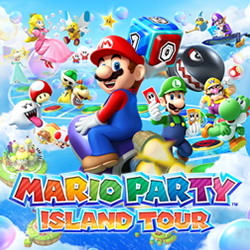Critical response
Mario Party: Island Tour received "mixed or average" reviews from critics, according to the review aggregation website Metacritic. [32] Fellow review aggregator OpenCritic assessed that the game received weak support, being recommended by 3% of critics. [33] In Japan, four critics from Famitsu gave Island Tour a total score of 32 out of 40, with each critic awarding the game an 8 out of 10. [34] Writing for Nintendo World Report, Kimberly Keller concluded: "Island Tour is a fine entry in the series that should bring out the competitive streak in all Mario Party fans, old or new." [2] Hollander Cooper of GamesRadar+ added: "Island Tour isn't the Mario Party you remember, and that's not necessarily a bad thing. That said, there are definitely some missing pieces that keep it from being a memorable entry in the franchise." [12] Writing for Shacknews , Steve Watts stated that the 3DS was "an odd choice", arguing that multiplayer-oriented party games like those in the Mario Party series conflicted with handheld systems being "innately a singular experience". [13]
The variety in the game boards, particularly the differing win conditions, was frequently praised, [2] [9] [10] though a few reviewers noted that most of the boards simply revolved around players attempting to reach the end first. [11] [14] [15] Critics also appreciated the ratings for factors such as luck and skill, as well as the estimated play times, [2] [11] [15] though some questioned the reliability of these statistics. [3] [13] Both Caitlin Cooke of Destructoid and Hollander Cooper of GamesRadar+ expressed disappointment with the series' traditional Star and coin system not returning in any of the boards. [10] [12] The short lengths of the boards were noted by several critics, [3] [12] [37] including Nintendo Life 's Dave Letcavage, who felt that this resulted in fewer minigames being experienced during each game. [6] Other reviewers criticized the pacing of the boards, [7] [37] attributing this to having to wait for the other players—including the computer-controlled characters—to complete their turns. [5] [11] [38]
Critical response to the minigame selection was also generally positive, with Letcavage calling it "one of the tightest collections of mini-games to be featured in the Mario Party series, optimized perfectly for pick-up-and-play sessions". [6] Digital Spy 's Liam Martin agreed that the minigames were "among the best we've played", [37] and Polygon 's Danielle Riendeau lauded the selection as not only the game's "greatest asset", but "possibly the best in the series". [5] Numerous reviewers commended the implementation of a wide range of 3DS capabilities. [3] [6] [8] [10] [36] However, IGN 's Scott Thompson was more critical of the minigame selection, stating that the motion control made some minigames awkward to play. Thompson also noted an absence of non-four-player free-for-alls, such as teams of two and three against one, which he referred to as "an odd departure for the series". [9] A handful of reviewers also spoke favorably of the minigame-focused game modes, [2] especially the free play mode. [6] [11]
Reception toward the game's single-player campaign, Bowser's Tower, was more mixed; although the boss minigames were found enjoyable, [6] [9] [14] the low and unchangeable difficulty levels of the player's AI opponents elicited criticism. [2] [9] GameSpot 's Heidi Kemps referred to this mode as "a nice diversion" but weak in comparison to Mario Party DS 's story mode, [3] Nintendo Life's Dave Letcavage wrote that it was "mostly fluff in its repetitive and lengthy design", [6] and IGN's Scott Thompson derided it as "laughably bad". [9]
Critics widely panned the game's emphasis on luck, [6] [35] especially in its minigames, [3] [14] [15] which The Guardian 's Andy Robertson believed caused minigames to sometimes feel inconsequential. [36] Other reviewers criticized certain game boards' reliance on luck rather than skill, [5] with Banzai Bill's Mad Mountain being almost entirely luck-based. [12] [37] The absence of an online multiplayer mode was also heavily criticized, [6] [14] [38] though many reviewers complimented the game's local multiplayer via Download Play, [3] [11] which was described as robust, [13] quick and easy, [35] and "where this game shines". [2] Nevertheless, a few critics observed occasional connection issues during local multiplayer. [9] [12] Certain reviewers also complained of a general lack of difficulty from the game's AI, [38] particularly during mingiames. [13]
On the topic of the game's aesthetics, Dave Letcavage of Nintendo Life described the visuals as "satisfactory, getting the job done without doing anything to wow", stating that the stereoscopic 3D neither added to nor interfered with any aspects of the game. [6] Kimberly Keller of Nintendo World Report added: "The graphics are crisp and utilize 3D well, while the music fits each game and board without becoming monotonous." Keller also mentioned the game's collectibles, writing: "It's a nice touch, but it's nothing more than a mildly interesting bonus." [2] Likewise, Kevin Schaller of GameRevolution found the collectible system "pointless" due to it mostly consisting of music tracks and character voice samples that can be heard elsewhere in the game. [14]
Sales
Mario Party: Island Tour sold more than 132,000 units within the first week of its release in Japan, making it the best-selling 3DS title that week. [39] As of April 9, 2014, the game had remained the best-selling title in Japan, selling an additional 47,000 copies for a total of 257,000 units. [40] The game became a Nintendo Selects title in Europe on October 16, 2015, [41] and in North America on March 11, 2016. [42] As of December 31, 2021, Mario Party: Island Tour had sold 2.95 million copies worldwide, making it the 24th-best-selling game for the Nintendo 3DS. [43]

